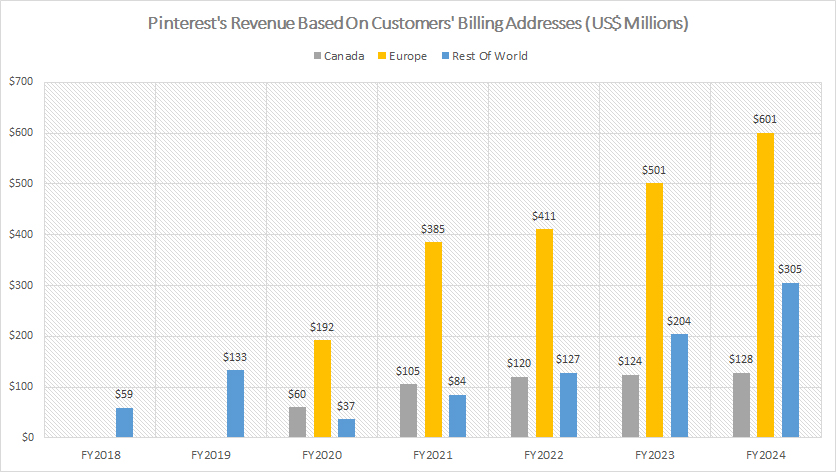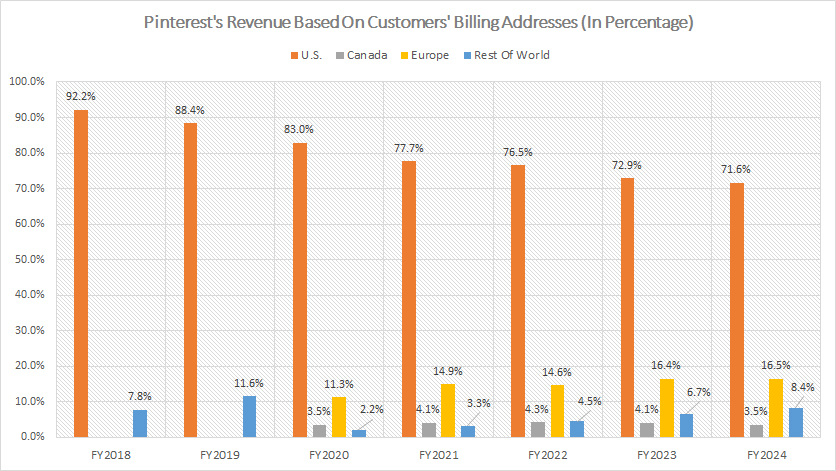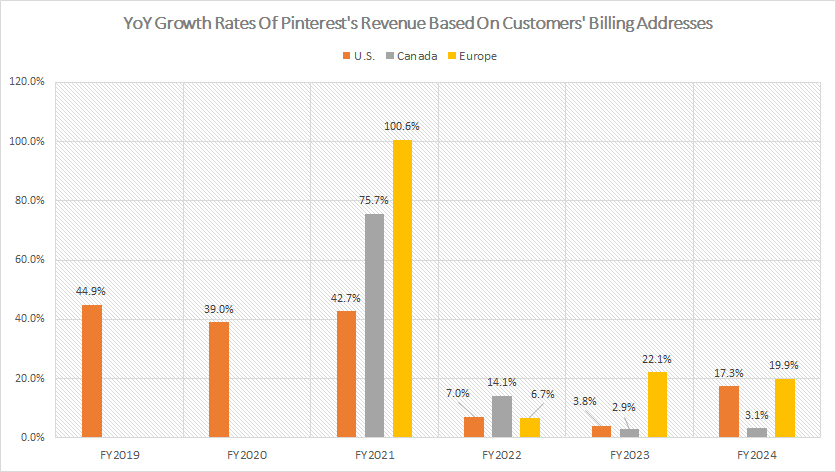
Like. Pexels Image.
This article presents Pinterest’s revenue distribution according to its customers’ billing addresses. Pinterest derives a significant portion of revenue from North America and Europe.
Pinterest’s North America includes the United States and Canada, while Europe includes Russia and Turkey.
Keep in mind that this allocation differs from the revenue disaggregated according to users’ geographic location when they perform a revenue-generating activity.
For revenue based on users’ geographic location when they perform a revenue-generating activity, you may find more information on this page: Pinterest revenue breakdown.
Let’s look at the details!
You may find other key statistic of Pinterest on these pages:
- Pinterest vs Meta, Snap and Twitter: profit margin analysis,
- Pinterest dividend: 5 reasons it will pay and 2 it will not, and
- Pinterest vs Meta, Twitter, and Snapchat: debt and cash comparison.
Please use the table of contents to navigate this page.
Table Of Contents
Definitions And Overview
O2. Why is Pinterest’s revenue concentrated in the U.S. market?
Regional Revenue
A1. Revenue From The U.S.
A2. Revenue From Canada, Europe, and Rest Of World
Regional Revenue In Percentage
B1. Percentage Of Revenue From The U.S., Canada, Europe, and Rest Of World
Regional Revenue Growth
C1. YoY Growth Rates Of Revenue From The U.S., Canada, and Europe
Summary And Reference
S1. Insight
S2. References and Credits
S3. Disclosure
Definitions
To help readers understand the content better, the following terms and glossaries have been provided.
Revenue By Region: Revenue by region presented here is geographically apportioned based Pinterest customers’ billing addresses.
For revenue based on users’ locations when they perform a revenue-generating activity, please visit this page: Pinterest revenue breakdown.
Why is Pinterest’s revenue concentrated in the U.S. market?
Pinterest’s revenue is heavily concentrated in the U.S. market due to several factors:
-
High User Engagement: The U.S. has a significant portion of Pinterest’s active user base, with many users engaging regularly with the platform. This high engagement translates into more opportunities for revenue generation through ads and other monetized features.
-
Advertising Demand: Advertisers in the U.S. are willing to invest heavily in targeted campaigns on Pinterest, as the platform provides access to a large and diverse audience. The U.S. market is particularly lucrative for digital advertising.
-
Established Infrastructure: Pinterest has a well-developed advertising and business infrastructure in the U.S., making it easier to attract and retain advertisers.
-
Cultural Fit: Pinterest’s focus on visual discovery and inspiration aligns well with U.S. consumer behavior, where users actively seek ideas for shopping, home improvement, fashion, and more.
-
Economic Factors: The U.S. has a strong economy with high purchasing power, which encourages advertisers to spend more on reaching potential customers through Pinterest.
These elements combine to make the U.S. a dominant market for Pinterest’s revenue generation.
Revenue From The U.S.
Pinterest-revenue-from-customers-in-the-USA
(click image to expand)
Pinterest apportions its revenue by region based on customers’ billing addresses. More information about Pinterest’s revenue according to customers’ billing addresses is available here: revenue by region.
Pinterest’s revenue is overwhelmingly concentrated in the U.S. market, overshadowing contributions from other regions. This dominant reliance on U.S.-based customers has been a defining feature of the platform’s financial success.
In fiscal year 2024, Pinterest achieved an all-time high revenue of $2.6 billion from customers in the U.S., marking a notable 17% increase from the $2.2 billion generated in 2023. This growth underscores the consistent demand and monetization opportunities within the U.S. user base.
Taking a closer look at recent years, Pinterest’s U.S. revenue experienced a remarkable 24% growth between fiscal years 2022 and 2024, climbing from $2.1 billion to $2.6 billion. These figures highlight the sustained expansion and profitability of the U.S. market.
Zooming out further, the scale of growth from fiscal year 2018 to 2024 is even more striking. Over this six-year period, Pinterest’s U.S.-based revenue has almost quadrupled, surging from $700 million to an impressive $2.6 billion. This exponential growth reflects the platform’s ability to harness the spending power and engagement of American users.
While other regions contribute to Pinterest’s global earnings, the dominance of U.S. revenue showcases the company’s strategic focus and success in capturing the domestic market.
Revenue From Canada, Europe, and Rest Of World
Pinterest-revenue-from-customers-in-Canada-Europe-and-international
(click image to expand)
Pinterest apportions its revenue by region based on customers’ billing addresses. More information about Pinterest’s revenue according to customers’ billing addresses is available here: revenue by region.
Pinterest’s revenue from customers based in Europe represents the second-largest revenue stream after the U.S., showcasing the region’s growing importance to the company’s financial performance. In fiscal year 2024, Pinterest’s revenue from Europe totaled $601 million, marking a 20% increase from the $500 million reported in 2023. This strong growth emphasizes Europe’s position as a key market for Pinterest’s advertising and monetization strategies.
Looking at the longer-term trends, Pinterest’s revenue from Europe has experienced a remarkable 46% rise from fiscal year 2022 to 2024, growing from $411 million to $601 million. This sustained growth reflects the platform’s ability to engage users in the region and attract advertisers who value Europe’s diverse and dynamic audience.
Meanwhile, customers based in Canada contribute only a modest share of Pinterest’s overall revenue. In fiscal year 2024, revenue from Canada stood at $128 million, showing little movement compared to the $120 million range reported in fiscal years 2022 and 2023. This stagnation suggests limited growth potential in the Canadian market, at least for the time being.
On the other hand, Pinterest’s “Rest of World” revenue has demonstrated significant growth and diversification, reaching $305 million in fiscal year 2024. This marks a substantial expansion beyond its core markets and reflects Pinterest’s increasing focus on tapping into new and emerging regions.
By diversifying its revenue streams geographically, Pinterest is taking steps to reduce reliance on its traditional markets and explore fresh opportunities for growth globally. The varied performance across these regions highlights Pinterest’s global expansion strategy and the challenges of maintaining consistent growth across markets.
Percentage Of Revenue From The U.S., Canada, Europe, and Rest Of World
Pinterest-percentage-of-revenue-from-the-U.S.-Canada-and-Europe
(click image to expand)
Pinterest apportions its revenue by region based on customers’ billing addresses. More information about Pinterest’s revenue according to customers’ billing addresses is available here: revenue by region.
From a percentage standpoint, Pinterest’s revenue share from the U.S. has shown a marked decline over the years, dropping from an overwhelming 92% in 2018 to 72% in 2024. This substantial reduction reflects the company’s success in diversifying its income streams by expanding its presence in other regions and tapping into global markets.
In contrast, Europe has emerged as a strong revenue contributor. Pinterest’s revenue share from Europe surged to 16.5% in fiscal year 2024, up from 11% in 2020. This growth highlights the increasing relevance of European users and advertisers to Pinterest’s overall financial performance. It also underscores the platform’s efforts to cater to regional preferences and leverage advertising potential in diverse European markets.
Canada’s revenue share, however, has remained steady at 3.5% between fiscal years 2020 and 2024. While the Canadian market continues to play a role in Pinterest’s global earnings, the lack of growth suggests a saturation of opportunities or slower adoption of revenue-generating features compared to other regions.
On the other hand, the “Rest of World” category has seen remarkable progress. Revenue share from these regions climbed significantly from 2.2% in 2020 to 8.4% in 2024. This sharp increase illustrates Pinterest’s growing foothold in emerging markets and underscores its efforts to attract users and advertisers from diverse geographies outside its core markets.
This diversification not only broadens Pinterest’s revenue base but also positions the company for long-term global growth. Overall, these trends paint a picture of Pinterest as a platform evolving from a U.S.-centric business to a truly global entity, with opportunities and challenges varying across regions.
YoY Growth Rates Of Revenue From The U.S., Canada, and Europe
Pinterest-growth-rates-of-revenue-from-the-U.S.-Canada-and-Europe
(click image to expand)
Pinterest apportions its revenue by region based on customers’ billing addresses. More information about Pinterest’s revenue according to customers’ billing addresses is available here: revenue by region.
Pinterest’s U.S. revenue showcased a significant rebound in fiscal year 2024, with the year-over-year growth rate climbing to 17%. This recovery marked a positive turnaround following two consecutive years of decelerating growth. The surge highlights renewed momentum in Pinterest’s largest market, fueled by strategies aimed at enhancing user engagement and optimizing monetization through advertising and subscriptions.
However, the recent growth rates in the U.S. still fall short when compared to the robust performances of earlier years. Between fiscal years 2019 and 2021, Pinterest experienced exceptional growth rates exceeding 40%, driven by a combination of increased user adoption, pandemic-induced online activity, and advertisers capitalizing on digital platforms. The deceleration post-2021 reflects a normalization of growth as the platform matured and external market conditions evolved.
On the other hand, Pinterest’s European revenue growth remained strong and consistent. Fiscal year 2024 saw a 20% year-over-year increase, closely aligning with the 22% growth reported in 2023. This steady expansion underscores the region’s growing significance to Pinterest’s global revenue strategy. The elevated growth rates indicate an effective penetration into European markets, supported by localized advertising campaigns and rising user engagement.
In contrast, Pinterest’s revenue growth from Canada has remained relatively subdued. As of fiscal year 2024, growth in this region was limited to just 3.1%. This stagnation, consistent with previous periods, suggests a lack of significant breakthroughs in user acquisition or advertiser investment within the Canadian market.
Meanwhile, Pinterest has seen noteworthy progress in its “Rest of World” segment, contributing to the platform’s diversification efforts. By strategically expanding into emerging markets and fostering global user engagement, Pinterest demonstrates an ambition to reduce reliance on its core regions and unlock new avenues for growth.
Overall, these trends highlight the varying dynamics across Pinterest’s global markets, with strong recoveries and steady growth in some regions contrasted by slower performances in others.
Insight
Overall, Pinterest’s ability to maintain strong growth rates in Europe and Rest of World reflects its adaptability and the global appeal of its platform.
Yet, the slowdown in U.S. growth compared to previous years and flat results in Canada underscore the importance of continuously innovating and tailoring strategies for mature and emerging markets alike.
Expanding into diverse regions not only mitigates risks associated with heavy reliance on a single market but also opens pathways for sustained global growth.
References and Credits
1. All financial figures presented were referenced and obtained from Pinterest’s quarterly and annual reports published on the company’s investor relations page: Pinterest Investor Relations.
2. Pexels Images.
Disclosure
We may use artificial intelligence (AI) tools to assist us in writing some of the text in this article. However, the data is directly obtained from original sources and meticulously cross-checked by our editors multiple times to ensure its accuracy and reliability.
If you find the information in this article helpful, please consider sharing it on social media. Additionally, providing a link back to this article from any website can help us create more content like this in the future.
Thank you for your support and engagement! Your involvement helps us continue to provide high-quality, reliable content.




